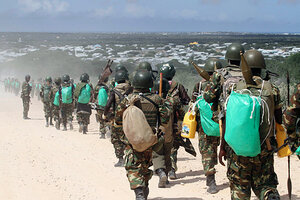Somalia, African Union forces attack Islamist-held camp
The effort is to push the Islamist militia Al Shabab further away from the outskirts of Somalia's capital, Mogadishu, but aid workers worry that displaced civilians in Afgoye camp may get caught in crossfire.

African Union Mission in Somalia (AMISOM) peacekeepers from Burundi patrol after fighting between insurgents and government soldiers on the outskirts of Mogadishu on Tuesday, May 22.
Feisal Omar/Reuters
Nairobi, Kenya
A major offensive aimed at clearing Somalia’s Al Qaeda-allied Islamist army from the world’s largest camp for displaced people began Tuesday, amid fears that civilians could end up in the firing line.
Columns of Somali National Army troops with African Union peacekeepers launched the attack soon after sunrise along a major road heading northwest from Mogadishu, the Somali capital.
Their aim, the AU’s most senior official in Somalia said, was to “build security” so that the 400,000 people squatting on Islamist-controlled territory outside the city would find it easier to be reached by aid agencies. The area, known as the Afgoye corridor, remains under the rule of Al Shabab, a radicalized fighting force bent on routing Somalia’s Western-backed government and ruling the country according to a strict interpretation of Islamic law.
Al Shabab has banned most international aid groups from working in its territory, despite the ongoing effects of last year’s famine and threats of further severe hunger after failed crops this year.
“The Afgoye corridor holds one of the biggest concentrations of internally displaced people in the world,” said Wafula Wamunyinyi, who heads the AU peacekeeping mission in Somalia, known as AMISOM. “We are helping them by building security so that they can share in the economic revival of the capital. They will now be able to access humanitarian services and eventually return to their original homes in Mogadishu.”
Mogadishu has seen its longest period of peace in many years recently, since the AU contingent – made up mostly of Ugandan and Burundian soldiers – forced Al Shabab from the capital last year. Where once there were daily mortar and small-arms battles along frontlines running down the city’s main streets, now it is rare to hear sustained gunfire.
Businesses are starting, markets are flourishing, and schools and clinics are reopening.
But there are still regular suicide attacks by bombers sent by Al Shabab, including one last month at the newly reopened Somali National Theater, which killed 10 people.
Many of those attackers are believed to come from the area around Afgoye, and AU commanders hope that Tuesday’s offensive, which is likely to last several days, will force them further from Mogadishu’s outskirts. But there were concerns that fighting in such a crowded area could lead to ordinary people being caught up in the conflict, or Islamist fighters melting into the population.
One aid worker in Nairobi, capital of neighboring Kenya, warned, however, that taking the battle to Al Shabab where there were so many civilians living in flimsy shelters was a substantial risk.
“It could be truly dreadful if Shabab pull back into the [internally displaced people’s] camps and start launching their fightback from there,” she said, refusing to give her name or organization because she was not authorized to talk to the media. “It’s true that we need to reach those people, it’s a desperate situation there. But it will be a disaster if people we need to treat for malnutrition suddenly really need treating for gunshots, mortar wounds, or other battlefield injuries.”
Lt. Gen. Andrew Gutti, AMISOM’s force commander, said that the attack had been “designed to minimize the harm to the population.”
“During this joint operation AMISOM is taking every precaution to prevent harm or injury to civilians,” he said. “We will only fight when attacked by the Al Shabab terrorists. We ask the population of the Afgoye corridor to continue to stay in their places of residence, avoid unnecessary travel on main roads, and not to stray far from their homes.”
Abdisamad Moalim Mohamoud, Somalia’s interior minister, said late Tuesday that government forces had made “a great achievement” during the first day of the offensive, taking the towns of Garasbaley and Daynile from Al Shabab.
But Islamist commander Sheikh Fuad Mohamed Khalaf told Mogadishu’s Radio Al Andalus that “the crusade forces from Burundi and Uganda and their Somali puppets launched an offensive, they were pushed back, they were given a lesson enough.”
“They left bodies and destroyed military trucks, we will show them to the media later today,” he added.
Eyewitnesses, however, said that they had seen at least five dead Al Shabab fighters, and one casualty from the government forces.
“Al Shabab was pushed back, they lost a good distance to the government forces, I saw five of their bodies, the government forces were kicking them,” said Osman Hilibi, who lives close to Garasbaley.
--Abukar Albadri contributed reporting from Mogadishu.

